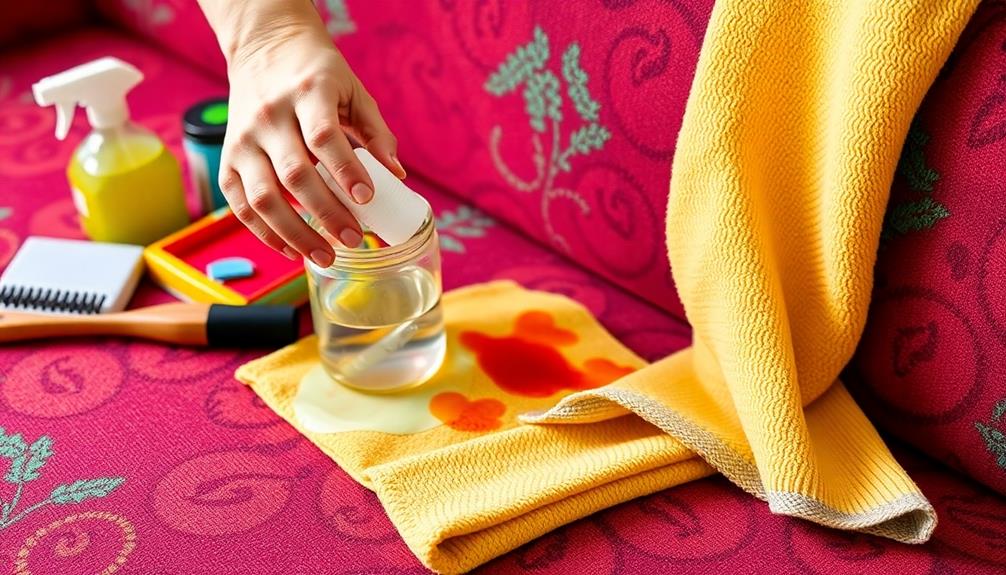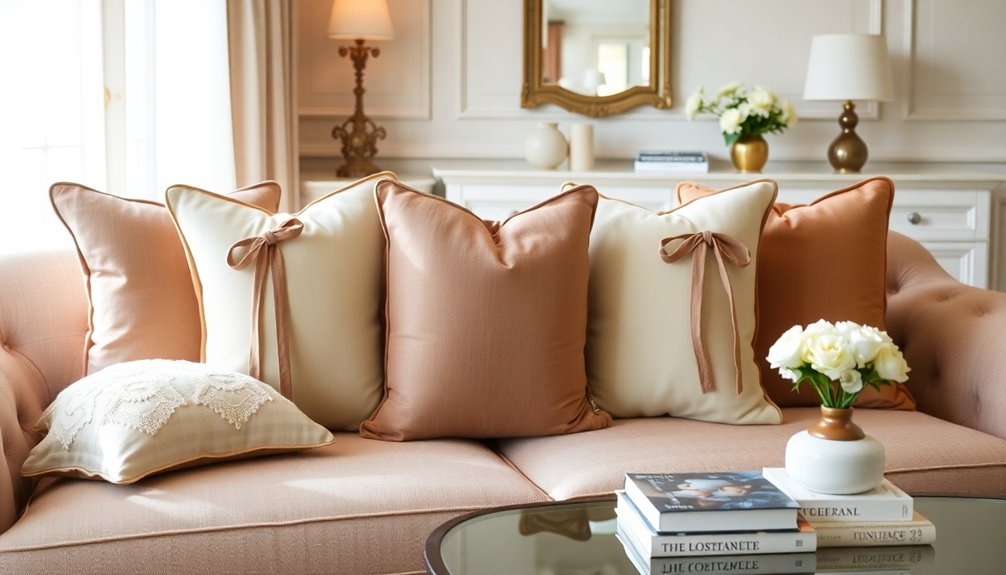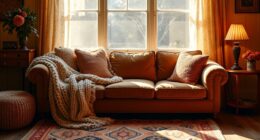To get rid of a stain on your sofa, it’s important to act quickly! First, check the fabric care tag to find the cleaning codes. For wet stains, immediately blot them with a dry cloth. For dry stains, scrape the area and then vacuum. A cleaning kit with white cloths, mild detergent, and baking soda can be helpful. For specific stains, like red wine, try pouring carbonated water and blotting, or sprinkle cornstarch on grease stains before vacuuming. Always do a spot test before using any cleaning solution. For more detailed methods on different stains, there are many options beyond these essential tips. If you have stubborn or set-in stains, consider using upholstery cleaner or a vinegar and water solution, following the fabric care instructions carefully. Removing stains from a fabric sofa can be challenging, so if the stain persists, professional cleaning may be the best option to prevent damage. Prevention is also important—using protective sprays can help make future stain removal easier.
Key Takeaways
- Act quickly on stains to prevent them from becoming permanent and increase removal chances.
- Always check the fabric care tag for appropriate cleaning codes before starting.
- Use blotting techniques for wet stains and scraping for dry stains to minimize mess.
- For specific stains, use targeted methods, such as baking soda for grease or vinegar for ink.
- Regular maintenance, like vacuuming and protective sprays, can help prevent future stains.
Importance of Quick Stain Removal

When it comes to removing stains from your sofa, acting quickly is vital. Quick action can mean the difference between a minor inconvenience and a permanent eyesore. When you address stains immediately, you greatly increase your chances of completely removing them. The longer you wait, the deeper those stains can penetrate fabric fibers, complicating the cleaning process.
Old stains often require more intensive methods, making immediate attention essential. Additionally, it's important to take into account potential allergens that may develop from trapped dirt and stains, which can affect your health and comfort in your living space. common types of cold medications might also be relevant if you're dealing with spills related to illness.
DIY cleaning methods typically yield the best results when applied promptly. If you let a stain sit, it'll set, leading to permanent discoloration. This not only affects the appearance of your sofa but can also become a breeding ground for bacteria and allergens.
In some cases, after procrastinating on a stain, you might find that it's too stubborn for home remedies. At that point, seeking professional help might be your best bet, which can be costly and time-consuming.
In short, for effective stain removal, prioritize swift intervention. The sooner you act, the better your chances of restoring your sofa to its original state and avoiding the need for more drastic measures later on.
Preparation for Stain Removal

Before diving into stain removal, it's essential to prepare properly to guarantee the best results. Start by checking the fabric care tag for the cleaning code, which can be W, S, S/W, WASH, or X. This will help you avoid damaging your sofa's material.
For wet stains, immediately blot the area with a dry, absorbent towel to soak up excess liquid. If the stain is dry, scrape off any residue and vacuum the area to minimize mess. Regular maintenance and cleaning can help prevent stubborn stains from setting in, so consider tips for maintaining clean surfaces.
Next, gather your cleaning kit. Include essentials like white cloths, mild detergent, vinegar, and baking soda, depending on the stain type and fabric material. Quick action is imperative; the sooner you address the stain, the better your chances of complete removal before it sets in.
Always conduct a spot test with any cleaning solution on a hidden area of the fabric. This guarantees that the solution won't cause discoloration or damage.
Common Stain Types and Solutions

When it comes to tackling common stains on your sofa, knowing the right techniques can make all the difference.
For instance, red wine, grease, and ink require specific approaches to effectively lift them without damaging your fabric. It's also important to take into account the type of fabric your sofa is made from, as this can impact the cleaning method you choose.
Additionally, using a vacuum with superior dust and allergen elimination can help remove any loose debris before you treat stains.
Let's explore some practical solutions for these pesky stains.
Red Wine Techniques
Red wine stains can be particularly stubborn, but quick action can make a significant difference in removing them. When a spill happens, the key is cleaning efficiently to prevent the stain from setting into your upholstery.
For added help, consider using essential oils such as eucalyptus oil for its antiseptic properties in your cleaning routine.
Here's what you should do:
- Immediately blot the stain with a clean, dry cloth to absorb as much liquid as possible—don't rub it in!
- Pour carbonated water directly onto the stain and continue to blot until the stain diminishes.
- Mix ¼ cup of baking soda with ⅓ cup water to create a paste. Apply it to the stain, let it dry completely, and then vacuum it off for effective stain removal.
Grease Stain Solutions
Grease stains can be a real headache, but tackling them doesn't have to be. Start by sprinkling cornstarch or baking soda on the stain, letting it sit for 15-20 minutes to absorb the oil. Afterward, vacuum it up. If you still see the stain, mix dish soap with warm water and use a soft brush, like a toothbrush, to gently scrub the area. Make certain to blot and remove any remaining soap with a moist paper towel.
For those stubborn stains, you might need to repeat the cornstarch or baking soda application until the stain disappears. Always check the upholstery cleaning code before using any cleaning products to verify they're safe for your fabric.
Here's a quick reference table:
| Step | Action |
|---|---|
| 1. Apply | Sprinkle cornstarch or baking soda |
| 2. Wait | Let it sit for 15-20 minutes |
| 3. Vacuum | Remove the absorbed powder |
| 4. Scrub | Use dish soap and warm water solution |
| 5. Blot | Wipe with a moist paper towel |
Ink Removal Methods
Ink stains can be particularly frustrating, but with the right techniques, you can effectively remove them from your sofa. In recent times, incidents like the Microsoft outage have highlighted the significance of maintaining a distraction-free environment, making it even more vital to address household issues promptly.
Here are some methods to tackle those pesky ink marks:
- Use a vinegar and alcohol mixture.
- Always check for colorfastness first.
- Think about professional cleaning for stubborn stains.
To start, mix one tablespoon of white vinegar with ¼ cup of rubbing alcohol. Dip a clean cloth into the solution and gently blot the stain. Remember, don't rub the stain as this can spread it further. Start from the outer edges and work your way toward the center.
Before applying the solution, it's important to test it on a hidden area of the fabric to verify colorfastness. If the stain persists, keep blotting with the solution until the ink is no longer visible.
Afterward, rinse the area with a damp cloth to remove any leftover residue.
If you've made several attempts and the stain remains stubborn, it might be time to think about professional cleaning, especially if your sofa is made of delicate or high-value fabric.
General Cleaning Methods

When tackling stains on your sofa, it's crucial to start with the upholstery cleaning code found on the care tag. This code indicates the appropriate cleaning method, such as W for water-based cleaning, S for solvent, or S/W for either.
For peak indoor air quality while cleaning, you might consider using an air purifier to help minimize allergens and dust that can be stirred up during the process. Before applying any cleaning solutions, vacuum the sofa thoroughly to remove loose dirt and debris, preventing deeper stains from setting in.
For water-safe sofa fabric, you can use a simple solution of dish soap mixed with cool water. Gently blot the stain without rubbing, as this can damage the fabric.
If you encounter stubborn stains, consider a stronger solution, like a combination of vinegar, baking soda, and warm water. However, always test this mixture on a hidden area first to verify colorfastness.
If your DIY methods fail to remove the stain, it might be time to call in a professional upholstery cleaner. They've the expertise and specialized stain removers to tackle high-value fabrics or persistent stains effectively.
Specific Stain Removal Techniques

When it comes to tackling specific stains on your sofa, knowing the right techniques can make all the difference. For instance, red wine, grease, and ink require distinct methods to effectively lift the stains without damage.
Additionally, understanding the materials of your sofa can aid in selecting the appropriate cleaning method, ensuring you maintain its integrity and longevity.
For those looking for energy-efficient models, the right cleaning techniques can also help preserve the fabric, much like how choosing the best heat pump can enhance your home's comfort.
Let's explore the steps you can take for each type of stain.
Red Wine Removal Steps
Red wine stains can be a nightmare for your sofa, but with quick action and the right techniques, you can often restore your fabric to its original state.
Understanding the importance of a budget for cleaning supplies can help you in managing costs effectively while dealing with such mishaps Budget.
Here are some essential steps to tackle that pesky stain:
- Always act fast; the sooner, the better!
- Use a cleaning combination of baking soda and water for stubborn stains.
- Consider a commercial cleaner if needed.
To start, grab a clean, dry cloth and gently blot the stain to absorb excess liquid.
Make sure to care not to rub, as this can spread the stain further.
Next, pour carbonated water directly on the stain and blot it dry; repeat this process until you see improvement.
If the stain lingers, create a paste using ¼ cup of baking soda mixed with ⅓ cup of water and apply the solution to the stain.
Let it dry completely before vacuuming it off.
Remember, acting quickly greatly increases your chances of complete stain removal.
If all else fails, don't hesitate to use a commercial cleaner specifically designed for wine stains, but always test it on a hidden area first!
Grease Stain Solutions
Stains come in various forms, and grease marks can be particularly troublesome on your sofa. To tackle a grease stain, first sprinkle cornstarch or baking soda on the affected area. Let it sit for 15-20 minutes to absorb the oil, then vacuum it away.
Using a dual-flush toilet system can help save water and manage household costs effectively. Next, mix a few drops of dish soap with warm water. Using a soft brush, like a toothbrush, gently scrub the stained area without applying too much pressure to protect the fabric.
After scrubbing, blot the area with a moist cloth or paper towel to lift the soap and grease residue. Repeat this process until the stain is removed.
If the grease stain remains stubborn, try applying a mixture of vinegar and warm water, but always test on a hidden area first to check compatibility with your sofa's cleaning codes.
If you've followed these stain removing steps and the stain persists, it might be time to consult a professional upholstery cleaning service. They've the expertise and tools to effectively remove tough stains without causing damage to your furniture.
Ink Spot Treatment Techniques
Ink stains can be a nightmare for your sofa, but you can tackle them effectively with the right techniques. To avoid potential damage, it's crucial to verify that the materials used in the sofa upholstery are compatible with your cleaning solutions—just like selecting appropriate jewelry materials for body piercings. Here's how:
- Mix the solution: Combine one tablespoon of white vinegar with ¼ cup of rubbing alcohol.
- Blot, don't rub: Use a clean cloth to blot the stain gently, preventing it from spreading.
- Rinse thoroughly: After removing the stain, rinse the area with cold water.
First, always test the vinegar and alcohol solution on a hidden area of the fabric to confirm it won't cause discoloration. Once you've verified it's safe, apply the solution directly to the ink stain.
Continue to use the cloth to blot until the ink is no longer visible, repeating as necessary. For stubborn ink stains, consider using a commercial stain remover designed for ink. Just be sure to follow the instructions on the product label.
After you've successfully removed the ink stain, rinse the area with water and blot dry. This step helps eliminate any residue from the cleaning solution, making sure your couch looks its best!
Professional Cleaning Services

When tough stains just won't budge, turning to professional cleaning services can be a game changer for your sofa.
These experts specialize in professional upholstery cleaning, using advanced techniques and equipment to tackle stains that DIY methods simply can't handle. For standard cleaning, you can expect to pay between $100 and $300, but if your sofa features high-end fabrics like suede, specialized care could cost up to $500.
Professional cleaners often offer customized contracts tailored to your specific stain removal needs, taking into account the fabric type and severity of the stain.
They can also provide consultations to determine the best cleaning approach, ensuring your furniture maintains its longevity and appearance.
If you've tried multiple DIY methods without success, or your upholstery care tags recommend specialized treatment, it's wise to seek help.
Maintenance Tips for Stain Prevention

Preventing stains on your sofa starts with proactive maintenance. By taking a few simple steps, you can keep your sofa looking fresh and clean while minimizing the risk of spills turning into permanent stains.
- Regularly vacuum to remove dust and crumbs.
- Apply protective upholstery spray for added defense.
- Use slipcovers to guard against wear and tear.
Start with vacuuming your sofa to eliminate dust and crumbs, which can embed in the fabric and become tough to clean.
Next, consider applying a protective upholstery spray. This creates a barrier against spills, helping maintain your fabric's integrity over time.
Using slipcovers also makes it easier to clean and shields your sofa from daily wear.
If a spill occurs, act fast! Blot the area with a clean, dry cloth to absorb the liquid before it sets in.
Avoid scrubbing, as this can worsen the situation.
Finally, educate everyone in your household about the importance of keeping food and drinks off the sofa.
Frequently Asked Questions
How to Get Stains Out of a Fabric Sofa?
To get stains out of a fabric sofa, check the care tag, blot fresh spills gently, and use a mixture of dish soap and water. Rinse well and let it dry completely to avoid marks. If stubborn spots remain, a fabric-safe upholstery cleaner may help lift the stain. To remove water stains from sofa cushions, it’s essential to blot the area gently and ensure even drying to prevent further discoloration. Avoid over-saturating the fabric, as excess moisture can worsen the situation or promote mold growth.
Can Old Stains Be Removed From Sofa?
Imagine finding an old wine stain on your favorite couch. Yes, you can often remove old stains. Act quickly, pre-treat with soap and vinegar, or consider a steam cleaner for tougher spots.
Does Baking Soda Remove Couch Stains?
Yes, baking soda can remove couch stains effectively. You'll want to apply it directly to the stain, let it sit for about 20 minutes, then vacuum it up for best results and freshness.
How Do You Get Dried Stains Out of Upholstery?
To get dried stains out of upholstery, vacuum first to remove debris. Then, apply a mixture of dish soap, white vinegar, and warm water. Let it sit, blot, and repeat until the stain's gone.
Conclusion
To summarize, acting quickly can make all the difference when it comes to removing stains from your sofa. Did you know that nearly 80% of all stains can be removed if treated within the first 30 minutes? So, don't wait! Keep your cleaning supplies handy and tackle spills as soon as they happen. With regular maintenance and the right techniques, you can keep your sofa looking fresh and inviting for years to come.









